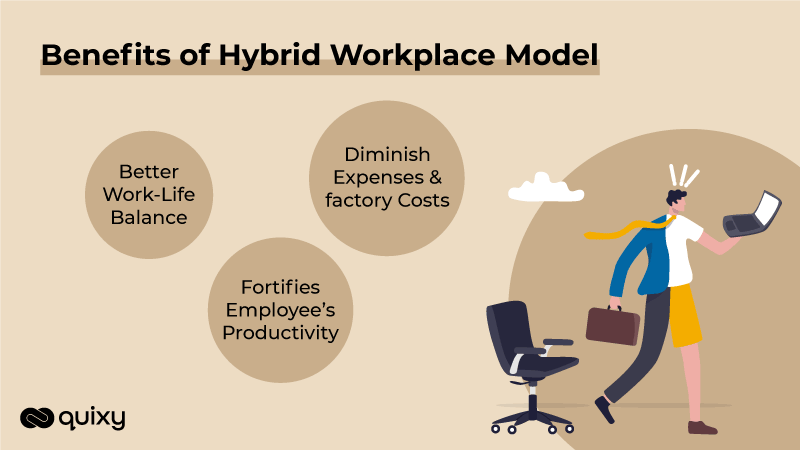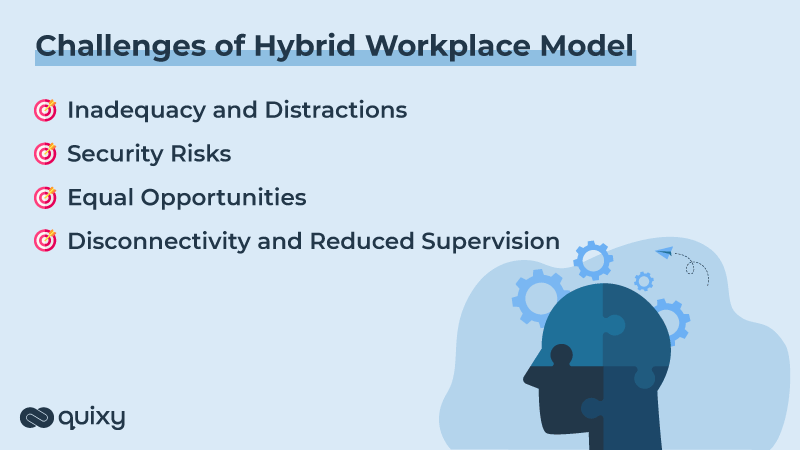
Wondering what is hybrid workplace model? Working from home seemed like a far-fetched dream a few years back for people who do not enjoy long commute times. It became a necessity in the previous two years and has now taken the shape of a progressive business strategy. The hybrid workplace model introduced as the product of the pandemic has made everyone capable of working at their best, no matter where they are.
A staggering 98% of the employees want to work from home at least some part of the time.
Yes we know, it was also labeled as annoying when the disturbance in the surroundings of your home affected work. But, we can not deny that the flexibility it offers outshines all the issues that come with it.
The concept of a working hybrid lets employees come out from their firm office space and enjoy working creatively anywhere.
What is a Hybrid Workplace Model?
Adapting the work culture with the reliability of either working from home or working from the office as per your convenience is a hybrid workplace model. With the hybrid nature of working, employees can get a mutable working environment.
The challenge is to extract profit from such flexibility of working. The major concern is to possess the flexibility of relocating the employees as per the work that needs to be done. The employees are flexible in choosing their work schedules and place of work as per the work done on a particular day. This can be achieved with specific guidelines as well as work policy to avoid losing work ethics and integrity as a whole.
This model will offer a new spirit of working in employees. However, it may also distract your work culture as you are in a habit of working at the pace of the office. The model of a hybrid workspace can fluctuate depending on the kind of work the organization offers. Nonetheless, optimizing productivity with all such fluctuations and challenges can make this model fruitful.
Also Read: 6 Tips to Successfully Manage Your Remote Workforce for Better Productivity
Workplace Innovation as a Part of the Hybrid Workplace Model
Workplace innovation is focused on workplace practices, which include co-created leadership, self-managed teamwork, trust-based systems, and processes. Workplace innovation can help organizations to achieve distinctive and robust workplace business models.
Encouraging workplace innovation within the organization helps companies lead the market and defend their bottom lines. Innovative workplaces help employees adopt the new work culture as they become a part of this change rather than being an audience. Adoption of automated workflow surely builds happier workplaces with consistently higher levels of employee satisfaction and retention.
Hybrid Workplace Model: Is it worth it for the Organizations?
The hybrid workplace model highly depends on the ability to adapt and the productivity of an individual organization. Whether the adopted policy in an organization is working or not is strictly connected with the outcome of the services provided. The revenue, productivity, and success of an organization depend on the honesty and efforts of the employees. The companies are now offering leniency in terms of work culture. The hybrid working will be worth it for the organization as the employees are now getting the reliability of completing their target as per their schedule in the respective deadline. They are also in dense need of such a work culture.
The major challenge of the companies is to fulfil their services on time as per customers’ requirements by making the employees work with a specific deadline. Here comes the role of leadership in managing the work culture accordingly. Altering the on-site work culture to a hybrid will diminish office footprints, which reduce employee-serving costs as well. However, several researchers analyzed that the hybrid work culture will certainly enhance productivity for many reasons:
- The efficiency of a hybrid work culture simulates employee performance.
- Employees come up with benefits like better work-life stability, no wastage of time in dressing up and commuting, enhanced savings as well and the satisfaction of working from anywhere. This will surely increase employees’ energy levels.
- Employees adopt flexible schedules to fulfill their targets which gives less stress and boosts their energy.
Building Hybrid Workplace Models
Alterations are not that easy. Companies face an open challenge while changing their work culture. The companies cannot directly declare the change in the work culture, and they need to develop forefront strategies before changing the culture to balance its productivity.
Building a hybrid work culture really means deciding which employees to come on which days, traversing online toolkits to every employee according to their needs, seeking employees’ work needs, and many more.
Building a hybrid workplace model requires intense strategic thinking to maintain the productivity of the organization. Hence, this work culture can be made effective and productive by focusing on technology, leadership, and the culture of working. Moreover, organizations can build hybrid culture intelligence by adhering to autonomous technologies to make the work more efficient, which eventually helps to enhance productivity.
Forthcoming Work Culture: Benefits and Challenges of Hybrid Workplace Model
Adopting a new platform or technology undoubtedly offers many benefits, but you can never adopt it with zero challenges. Every employee is now aware of the fact that the future comes with a different work culture. Such a culture has to be adopted by the employees to enhance the productivity of the company.
Employees all around the world are adopting this hybrid work culture; however, many employees are wondering whether to adopt this culture and find it difficult to go with it.

1. Better Work-Life Balance
People feel happy and excited when they get the freedom to work according to their set schedules. They get the flexibility of choosing their days of working on-site or working from home. The hybrid working model hence offers a balanced workload and helps employees maintain work-life contentment.
2. Diminish Expenses and Factory Costs
The hybrid Workplace Model helps organizations reduce their office expenses. For instance, fewer employees in the office imply reduced working space, which eventually implies smaller offices with lower rents and utility costs. With the adoption of specific workplace rotations, space can be reduced to a certain level. Hence, organizations can diminish their official space and move to smaller cities as well. This can result in a prominent reduction in utility bills for things like printers, desks, and electricity.
3. Fortifies Employee’s Productivity
The hybrid model simulates employees being more productive for the company, which is a strong commitment to work. There can be several reasons that hook up productivity. For instance, enhancement in autonomy can give reliability to opt their working hours, employees can save commuting time, can also save time that gets wasted in the number of Starbucks in the office. That is really true!
Challenges of the Hybrid Workplace Model

1. Effective Management
A hybrid work culture sometimes becomes an interruption due to the bad wifi connection of the employee. Outside noises may cause disturbance during meetings. These can also lead to inadequacy while working and distractions. Companies need the best synchronization techniques to make employees effective on duty. For instance, companies should use digital automation tools to track their employees and make them more productive.
2. Possibilities of Security Risks
Hybrid work culture is undoubtedly a great decision, but security will be a major concern that is at risk. The organization needs to be concerned about security and end-user education, as the employees are now using their networks and devices.
Also Read : Remote Workforce Management 101: The Ultimate Comprehensive Guide
3. Equal Opportunities
Managers in the hybrid environment need to be more careful with both the on-site and remote employers. He should ensure that both kinds of employees are getting equal opportunities to grow. The managers should evaluate the performance based on the production, not on the process of the work being done.
4. Feeling of Disconnectivity in the Employees Working From Home
Sometimes, there comes a situation for emergency meetings while working on ongoing projects where all team members need to join. However, the bad wifi of any team member will make them unaware of the meeting schedules. Employees working from home should never feel isolated or disconnected, and sometimes, because of not being on-site, there can be a lack of supervision that employees may encounter. The meetings should be recorded and managed.
Watch Webinar: Overcome the Top 12 Digital Workplace Challenges
Best Practices of Hybrid Workplace Model
That was a necessity during the pandemic when everything was driven to work from home. Most companies go through losses and face that abrupt situation. But now is the time to think smartly and go with the rhythm of hybrid work culture by adopting best practices to improve productivity.
1. Adopt Methodologies, Technologies, and Tools to Increase Productivity
Organizations must redesign their work culture by making use of mobile-enabled communication devices that help in improving productivity. Moreover, offer safe and healthy pieces of equipment amd tech tools to work comfortably from home.
2. Regular Training Sessions for the Managers and Team Members
Companies have to keep track of offering a variety of learning content as per the needs of attaining an objective.
3. Automates the Environment
To track the performance metrics of the employees as well as their production, the company needs to use reliable tracking automation tools.
Will Workplace Innovation enhance productivity?
Working innovatively implies the procedure through which an organization invents new products and ideas or approaches existing processes, ideas, and products in new ways. The hybrid work culture offers limitless opportunities for innovation. For Instance, innovation can be achieved by engaging yourself with three major perspectives, i.e., leadership, technology, and culture of the workplace.
While working in hybrid work culture, dedicated employees can be innovative by contributing creative ideas to overcome the challenges of the company. The lateral thinking of the employees as well as employers, may eventually optimize the productivity of the company.
Workplace innovation needs proper planning and testing of your ideas before using them for customer services. Undoubtedly, innovation can be productive but needs proper verification as well as validation.
Most importantly, workplace innovation is currently a huge challenge for a hybrid work culture but can be attained via effective brainstorming and acquiring best practices. Undoubtedly, it is a challenge, but it offers plenty of innovative strategies. Just need to figure it out!
Also Read: Best Productivity Tools to add more hours to your day!
Conclusion
New things come with challenges, and figuring out them and overcoming them is a challenge. Likewise, building a hybrid work culture is highly effective, but sustaining it is a big challenge. The hybrid workplace model can be effective and leads to high production. This model, moreover, can build massive revenue for the company if the employees work as a team and dedicate themselves to the best future of work.
Frequently Asked Questions(FAQs)
Q. How does Workplace Innovation fit into the Hybrid Workplace Model?
Workplace innovation is integral to the hybrid workplace model as it facilitates seamless collaboration, communication, and productivity across both physical and remote work environments. By leveraging innovative technologies and flexible work practices, organizations can create an environment that fosters creativity, efficiency, and employee engagement regardless of location.
Q. What is Hybrid Workplace Model?
A hybrid workplace model combines remote work and in-office work, allowing employees to work from both home and office environments based on their needs and preferences.
Q. Is the Hybrid Workplace Model beneficial for Organizations?
Yes, the hybrid workplace model offers various benefits for organizations, including increased flexibility, improved work-life balance, and enhanced productivity.
Q. How can Organizations effectively build Hybrid Workplace Models?
Organizations can effectively build hybrid workplace models by implementing flexible policies, investing in technology infrastructure for remote collaboration, and fostering a culture of trust and communication among employees.
Q. What are the anticipated Benefits and Challenges of the Hybrid Workplace Model?
The anticipated benefits of the hybrid workplace model include improved work-life balance, reduced expenses, and increased productivity. However, challenges such as effective management, security risks, and maintaining equal opportunities may arise.
Subscribe
Login
Please login to comment
0 Comments
Oldest
















